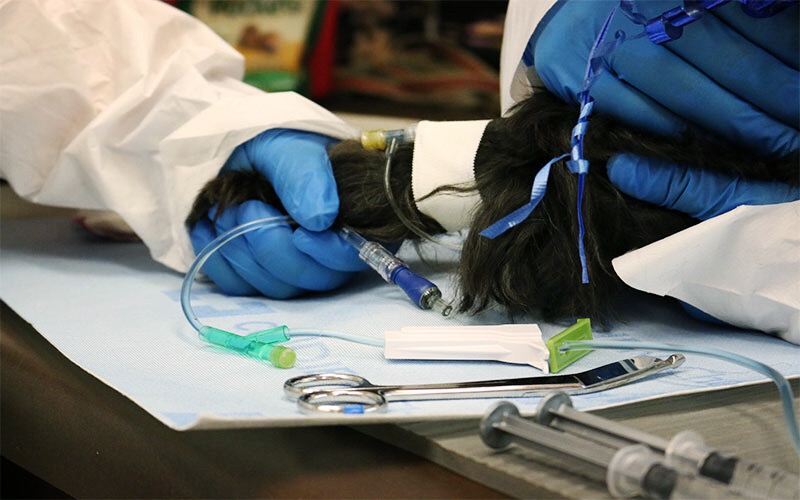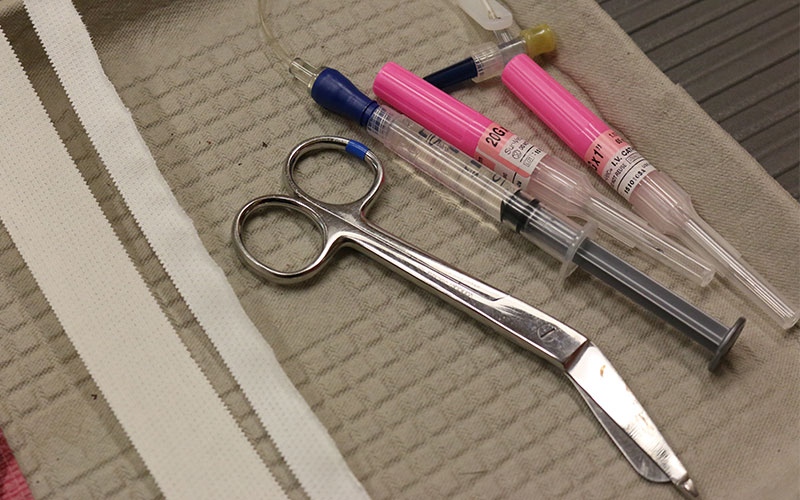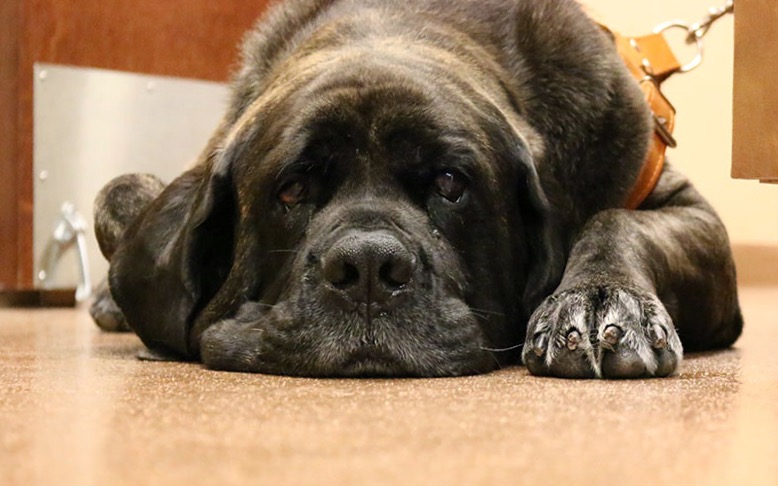
Michelle Friedrich, a certified veterinary technician at Arizona Veterinary Oncology in Scottsdale, keeps 9-year-old Scottish terrier, Molly, calm as she receives chemotherapy treatment for bladder cancer. (Photo by Alexa Salari/Cronkite News)

Molly receives chemotherapy treatment for her bladder tumor at Arizona Veterinary Oncology in Scottsdale. She’s been undergoing treatment for nearly 10 months. Her tumor has shrunk, but it’s located in an area doctors cannot surgically remove. (Photo by Alexa Salari/Cronkite News)

Some medical supplies needed to administer chemotherapy treatment to dogs: a catheter, which is a medical device inserted into the vein of dog to treat the disease, and needles filled with saline to dilute chemotherapy drugs. (Photo by Alexa Salari/Cronkite News)

Seven-year-old English mastiff, Sophie, waits to receive chemotherapy treatment for lymphoma at Arizona Veterinary Oncology in Scottsdale. She’s been receiving treatment since February 2016. (Photo by Alexa Salari/Cronkite News)
SCOTTSDALE – Keith and Marna McLendon thought their 9-year-old Scottish terrier, Molly, had a mere bladder infection.
But after a visit to the veterinarian and an ultrasound exam, the McLendons learned Molly had a tumor.
“We were actually surprised at the diagnosis of her first ultrasound,” said Marna McLendon, a Scottsdale resident. “We were just thinking that somehow everything would be fine. So, it hit hard.”
The scottie’s owners take her for chemotherapy treatment every three weeks at Arizona Veterinary Oncology in Scottsdale.
Despite undergoing nearly 10 months of chemo, Molly hasn’t lost her energy – or even her fur.
“Chemotherapy for people is an incredibly tough thing. There’s a lot of side effects, the challenges with it are very difficult,” said Dr. Rachel Venable, veterinary oncologist and Molly’s primary doctor. “But in dogs, they actually do extremely well. We see minimal side effects. Most the time, you would never know a dog was on chemotherapy.”
That’s just one reason doctors are looking to canines to advance cancer treatment for humans.
Researchers at the nonprofit Translational Genomics Research Institute in downtown Phoenix are growing their knowledge of canine cancers. They’re building a database of DNA samples from canines to compare the genetic makeup of healthy dogs to dogs with cancer. They hope this will lead to more targeted treatment options and potential cures.
Cancer a “major problem” for pet owners
One out of every three dogs is affected by cancer and of those, more than half of them will die from the disease, according to the National Canine Cancer Foundation.
That rate is alarming for many pet owners, considering there are more than 70 million pet dogs in the U.S., according to the American Pet Products Association.
“There’s no question that it’s a major problem for pet owners, and it’s certainly a major problem for dogs,” said Jeffrey Trent, president and research director at TGen.
Venable said she has seen the number of dogs with cancer grow over the past decade.
“People are taking better care of their animals than they used to back in the day,” she said. “And also, they’re living with us now inside. So, they’re living to be older. … The older you get, the chances of getting cancer just gets that much higher. Same with people.”
And treating cancer isn’t cheap. Treatments can include chemotherapy, surgery and radiation – with costs ranging from hundreds to thousands of dollars, Venable said.
TGen officials want to lower the rate of dogs with cancer. The institute has been collecting genetic information on dogs with cancer since 2010.
Researchers are using liquid biopsies to collect DNA samples via blood, saliva and urine. Those samples are analyzed through Illumina technology, an advanced genomic sequencing system.
This system allows researchers to input samples into the sequencer, which spits out data relaying the genetic landscape of a dog – essentially its blueprint.
“Using the lens of genetics to zero in on what changes are present in a cancer of lymphoma, bladder cancer, melanoma, allows us to target the treatment to a specific genetic change,” Trent said.
Liquid biopsies allow researchers to gather DNA samples without surgery. This lessens the risk for dogs, minimizes costs and allows TGen researchers to analyze information on a more continuous basis.
“It’s the holy grail of being able to work on targeted treatments,” Trent said.
Why look to dogs to advance treatment for humans?
“Dogs and humans have a great degree of genetic similarity that enables us to transfer knowledge across species,” said William Hendricks, an assistant professor at TGen specializing in canine cancer studies. “So, if we find a particular mutation in a canine cancer, that mutation often occurs in a very similar position in a human genome.”
With or without fur, cancer is a genetic disease.
“It’s a disease of broken genes in both humans and dogs,” Hendricks said. “This same genetic foundation exists for cancer. … The cancer tends to look similar under the microscope. They look similar under the genomic sequencer, and they tend to behave the same ways when they’re treated in the clinic.”
Aside from similar genetic landscapes, dogs share our physical environment.
For example, Trent said dogs that get lung cancer don’t smoke, but they may live with an owner who does.
It’s this combination of genetic and environmental similarities that provides doctors a unique way of comparing canine cancers to human cancers.
“Dogs, they’re a great model not only because they get similar cancers as we do, but they also live with us,” Venable said. “So, they share the same environment, the same exposures, sometimes the same foods. And so in that way, they’re a great model.”
The shorter lifespan of dogs also allows researchers to capture more data in a quicker time frame compared to studying humans over a period of several decades.
Researchers suggest more clinical trials for canines
A group of scientists recently published a review in “Science Translational Medicine” that suggests dogs with cancer be integrated into clinical trials to test new drug therapeutics.
This suggestion partly stems from the idea behind the Human Genome Project, said Trent, who contributed to the review.
National and international partners completed the 10-year and nearly $3 billion genome project in 2003. It sequenced and mapped the genes of humans to more clearly understand their genetic makeup.
Since that time, “more than 30,000 human cancers have been genomically profiled, (whereas) genomic sequence data have been published for fewer than 50 canine cancers,” according to the review.
Trent said researchers have focused on humans, which has led to the lag in data for dogs.
“There’s nearly 800 cancer treatments that are moving towards clinical trial for treatment in human patients and really, what we also wonder is whether some of those new drugs, those new targeted opportunities to treat cancer, could be helpful for our canine patients as well,” Trent said.
The group suggested veterinary schools help conduct canine cancer studies. Universities tend to have more staffing capable of observing and analyzing patients for a longer period of time.
Some Valley groups already have formed collaborations.
Venable said Arizona Veterinary Oncology recently partnered its oncology services with Midwestern University in Glendale. Venable sees about 30 to 45 canine patients every week.
She also said the practice is actively seeking clinical trials to advance the treatment of cancer.
Researchers stress safety in studies
For both TGen and Arizona Veterinary Oncology, they said ensuring the safety and humaneness of studies and clinical trials is of utmost importance.
“This is an area that really does have a lot of advocates on both sides – those that want to protect animals and those that want the best for them and those that want to get new cancer treatment for patients,” Trent said.
Trent said pets can’t make decisions for themselves, so they have to work hard to ensure they conduct studies with oversight and compassion.
“It’s an exciting blend of the ethical, legal, social implications of the work we do and an important one as well,” he said.
Molly’s owner said she is open to canine clinical trials. Her terrier’s tumor has shrunk. However, Molly’s doctor said they cannot surgically remove it because of its location.
Venable classifies Molly’s chemo treatment as more of a “maintenance therapy” that shrinks the tumor and prevents it from spreading to other parts of the body.
“One thing that really surprises owners is how their dog can feel kind of sick from their disease and then we start treating them with chemotherapy, especially lymphoma, and they notice how they start feeling better,” Venable said. “They have more energy. They are eating better, and it’s actually happening on chemotherapy, which would be the opposite of what you would expect.”
The type and length of cancer treatments for dogs varies, but Venable said most forms of treatment last about a year, with either one or two visits per month.
At the end of the day, however, chemo treatment gives patients like Molly what many humans are also trying to find: more time to live life.
Molly’s owners are making sure she spends her remaining time living life to the fullest.
“We started just focusing on quality of life,” Marna McLendon said. “We were just going to make the best of every day. If that meant we’re going to go on rides, we’re going to go on overnights. … We’re going to make sure she was feeling good every day that she could.”